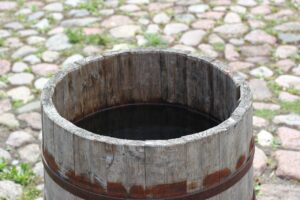Rain barrels are great for collecting water, especially in areas where it rains frequently. They allow you to save water for later use and can also be used to water plants or wash your car. When picking out a rain barrel, make sure that it’s big enough to hold all of the rainwater collected from your roof. You should also consider painting or otherwise decorating your barrel so that it matches your home’s exterior color scheme or garden theme!
Rain barrels are containers that hold rainwater.
A rain barrel is a container that holds rainwater. Rain barrels can be used to catch and store water from your home’s roof, which can then be used for watering plants or other purposes.
Rain barrels work by collecting the runoff from your roof when it rains, filtering out any debris and contaminants before storing the clean water for later use. Rain Barrels are typically made of plastic or metal and range in size from 30 gallons up to 120 gallons (though most commonly 50-55 gallon). They’re easy to install–simply place them under downspouts or gutters on your home’s exterior, then connect them with tubing leading into the house through an overflow valve (which prevents overflow). You can also add optional filters at this point if you’d like even cleaner water entering into your system!
Once installed correctly, these systems will save money by eliminating wasted runoff during heavy rains; additionally they’re good for the environment because less stormwater runoff means fewer pollutants entering local waterways such as lakes/rivers etcetera…
Rain barrels allow you to save water for later use.
Rain barrels are a great way to collect water. You can use the water for watering plants, cleaning and washing your car, and even washing your dog or windows.
You can attach a hose to a rain barrel and water your plants with it.
If you have a rain barrel, you can connect a hose to it and use the water to water plants. You can also use it to wash your car or water your lawn.
In addition to these uses, some people like to collect rainwater because they believe it contains beneficial minerals that tap water lacks. However, there is no scientific evidence for this claim; studies have found that both types of liquid are equally healthy for humans when consumed in moderate amounts (less than 2 liters per day).
A lot of people paint their rain barrels to make them look nice.
You can paint your rain barrel to match your house, garden or patio. You could even paint it to match the car you drive or your furniture. Or you could paint it to match your dog!
It’s really up to you, but I would advise against painting them in a pattern of polka dots.
Rain barrels have screens on top to keep out bugs and leaves.
Rain barrels have screens on top to keep out bugs and leaves. This is important because if you don’t have a screen, the water could become contaminated with unwanted debris. Also, if your rain barrel gets dirty, it won’t be able to filter out pollutants in the air or any chemicals that may be in your water source (like chlorine).
You should position your rain barrels where they receive the most rainfall.
The next step is to determine where you should place your rain barrels. You want them to be exposed to as much rainfall as possible, but also protected from wind and sun. In dry climates, it’s best if they’re sheltered from the elements by being placed under an eave or other overhang; in rainy climates with high winds and lots of sunlight exposure (like Florida), placing them out in the open will allow for maximum evaporation and runoff.
You can connect multiple rain barrels together to increase storage capacity.
You can connect multiple rain barrels together to increase storage capacity.
You can connect your barrels in series, parallel or a combination of both.
- Series- connecting two or more barrels together so that water flows from one barrel into another. This is a good option if you have low pressure to your house and want to avoid using an electric pump. You may also be able to reduce the cost of purchasing additional parts like filters and valves because you won’t need them for every barrel (although this might not always be true).
- Parallel- connecting multiple barrels together but each one has its own outlet valve at the bottom of it so there’s no cross-contamination between them (this means that when one barrel fills up with water from rainfall or snow melt then all other connected barrels will fill up as well). This kind of setup is great if space is limited but still offers plenty of capacity; however, each individual container needs its own filtration system so they don’t become contaminated over time due to stagnant water sitting inside them during hot summer months when rainfall isn’t happening very often (this could happen if someone forgets about their system–which happens more than people think!).
Rain barrels are great for collecting water!
Rain barrels are a great way to save water and reduce runoff. Rain barrels can be used for irrigation, or they can be used as drinking water for pets. Rain barrels help the environment because they reduce the amount of runoff that goes into storm drains and pollutes waterways.
Conclusion
So, what do you think? Are you ready to start collecting rainwater? If so, we hope these tips have been helpful! Remember that it’s important to position your rain barrels where they’ll receive the most rainfall. You also want them close enough together so that they can be connected (this way, each one will increase storage capacity). And finally, don’t forget about keeping them clean: if anything gets inside your barrel (like leaves or bugs), then it could contaminate your water supply.
